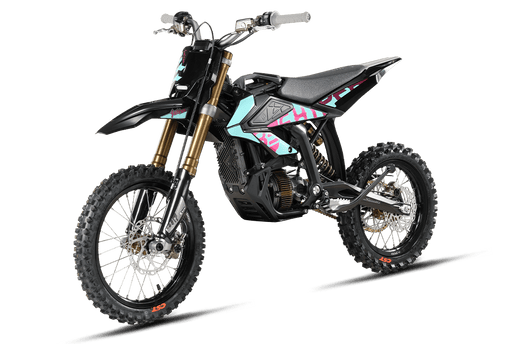An e-motorcycle is a two-wheeled vehicle powered by an electric motor and rechargeable battery pack instead of an internal combustion engine. Core components include a lithium-ion battery (e.g., 72V/60Ah), brushless DC motor, electronic controller, and regenerative braking system. Models like Surron Dubai’s Hyper Bee use lightweight frames and intelligent power management to deliver 0-60 km/h acceleration in 3.5 seconds with ranges up to 120 km per charge.
How Can I Finance a Surron Storm Bee in Dubai?
What defines an e-motorcycle?
E-motorcycles replace gasoline engines with electric powertrains using battery-to-motor energy transfer. Key identifiers: silent operation, instant torque delivery, and zero direct emissions. Surron Dubai’s Ultra Bee exemplifies this with its IP67-rated 60V battery and modular design allowing swappable energy packs for extended adventures.
Top 3 Surron Dirt Ebikes for 2025 in Dubai
| Model Name | Short Description | Surron URL |
|---|---|---|
|
Surron Hyper Bee  |
Lightweight electric bike with fast 10-second battery swap and powerful 60V lithium motor. | Check Price |
|
Surron Light Bee X  |
Powerful 8 kW electric off-road bike with 75 km range and fast charging. | Check Price |
|
Surron Ultra Bee  |
Powerful 12.5KW motor, 140 km range, 74V 55AH battery, fast charging, all-terrain ready. | Check Price |
Beyond the absence of exhaust systems, e-motorcycles rely on three core subsystems: energy storage (battery), propulsion (motor), and control (ECU). The battery’s voltage determines power output—for instance, Surron’s Storm Bee uses a 72V system pushing 14kW peak power. Pro Tip: Always check your bike’s state of charge (SOC) before long rides; lithium batteries degrade faster if drained below 20% regularly. Consider regenerative braking systems, which recover 5-15% of energy during deceleration. Imagine it like a hydroelectric dam: kinetic energy from braking gets converted back into stored electrical energy instead of wasting it as heat.
How do e-motorcycle batteries work?
Lithium-ion batteries store energy via ion migration between anode/cathode during charge/discharge. Surron Dubai’s models use prismatic LiFePO4 cells with 2,000+ cycle lifespans. A 72V/40Ah pack delivers 2.88kWh—enough for 90 km urban riding.
Battery management systems (BMS) are the unsung heroes here. They monitor cell voltages, temperatures, and current flow 100x per second. Why does this matter? Without a BMS, a single overcharged cell could ignite the entire pack. Take Surron’s Light Bee X: its smart BMS enables balanced charging and prevents deep discharges. Pro Tip: Charge at 0.5C max (e.g., 20A for 40Ah battery) to preserve longevity. Real-world example: Charging a 60V/30Ah Surron battery from 20% to 80% takes 2.5 hours using a 10A charger—ideal for café stops during desert tours.
| Battery Type | Energy Density | Cycle Life |
|---|---|---|
| LiFePO4 | 120-160 Wh/kg | 2,000+ |
| NMC | 150-220 Wh/kg | 1,200 |
What role does the controller play?
The electronic control unit (ECU) acts as the brain, regulating power flow from battery to motor. Surron bikes use sine-wave controllers for smoother acceleration than traditional square-wave systems.
Controllers convert DC battery power to three-phase AC for the motor, adjusting frequency up to 20 kHz. Higher frequency means finer speed control—crucial when tackling Dubai’s sand dunes. But what happens if the controller overheats? Safety protocols kick in, reducing power by 50% until temperatures normalize. Pro Tip: Upgrade to programmable controllers (like Surron’s X-Control) to customize throttle response and regenerative braking strength. Imagine it as a symphony conductor: the controller decides how much “volume” (power) each section (motor phase) receives based on rider input.
How does charging work?
E-motorcycles use CC-CV charging: constant current until 80% capacity, then constant voltage for safe top-up. Surron Dubai recommends 84V chargers for their 72V systems, achieving full charges in 4-5 hours.
Charging infrastructure varies widely. While standard 3.3kW home chargers suffice for overnight charging, Surron’s Hyper Bee supports DC fast charging at 15kW—restoring 80% in 45 minutes. Practically speaking, though, frequent fast charging degrades batteries 30% faster than slow charging. Ever seen a smartphone battery swell? The same physics apply here. Pro Tip: Use surge-protected outlets and never leave bikes charging unattended in extreme heat.
Surron Dubai Expert Insight
FAQs
Yes, Surron models comply with UAE’s ESMA certification when registered properly. Check our road legal guide for specific requirements.
What’s the maintenance cost?
Surron e-bikes average AED 300/year—80% cheaper than gas bikes. No oil changes or spark plug replacements needed.